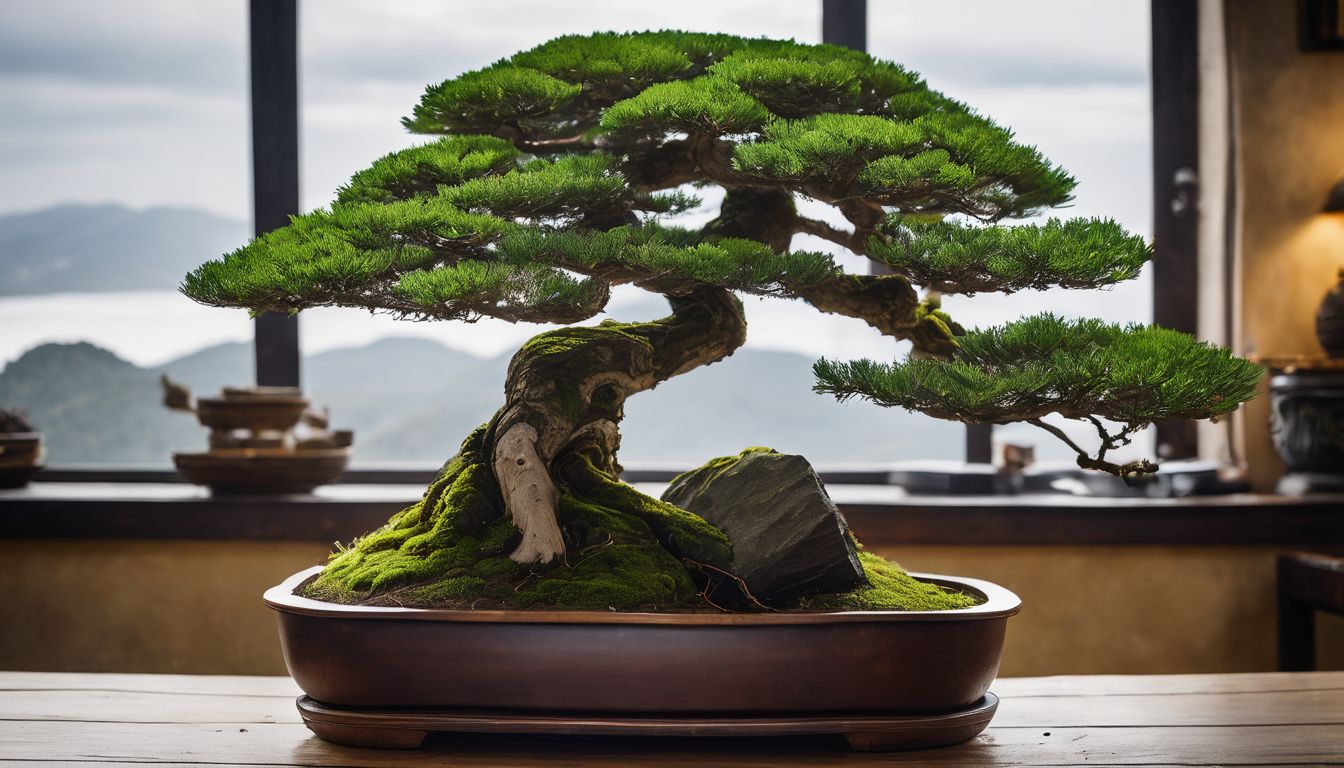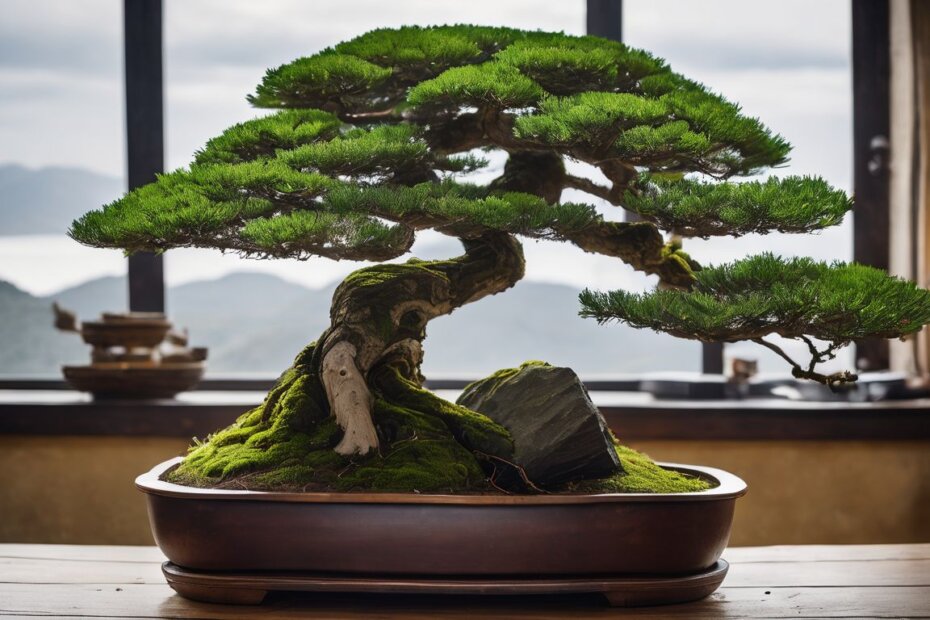 Wiring a bonsai tree is like giving it a gentle nudge in the right direction. Imagine trying to tell a tiny tree how to grow, shaping it into an elegant form that fits your vision.
Wiring a bonsai tree is like giving it a gentle nudge in the right direction. Imagine trying to tell a tiny tree how to grow, shaping it into an elegant form that fits your vision.
It’s not always easy, and one question often pops up: How long should those wires stay on?? If you’re new to this delicate dance of bonsai shaping, figuring out the timing can be tricky.
Here’s an interesting fact: bonsai trees are as unique as people, with different species requiring different care when it comes to wiring. Whether you have a fast-growing ficus or a slow-moving juniper, we’ve got tips for every twist and turn.
Our article will guide you through deciding how long to leave wires in place without harming your leafy friend. Keep reading; we’ll show all the secrets behind perfecting this age-old art!
Key Takeaways
- The time to leave wire on a bonsai tree depends on the species, growth rate, and branch thickness. Fast-growing trees might need wire removed faster, while thick branches could take months.
- Check your bonsai’s wired branches regularly for damage like cuts or indents in the bark. Adjust when needed to allow proper growth without harming the tree.
- Use anodized aluminum wire that matches branch thickness for best results. Remove it after 2-3 months or check sooner if you see signs of stress.
- After taking off the wire, look over your bonsai for any harm and keep giving good care like water and sunlight. This helps your tree stay healthy after wiring work.
- If you’re unsure about removing wires or caring for your bonsai, ask a pro for help. They can give advice based on your specific tree type and condition.
Factors Affecting Length of Time to Leave Wire On
The species of bonsai tree, its growth rate, and the thickness of its branches all play a role in determining how long to leave wire on. These factors will influence the duration needed for proper shaping and training of your bonsai tree.
Species of bonsai tree
Different bonsai trees grow at various speeds. Faster-growing species like the ficus or juniper may need wire removal sooner than slow-growers such as pines. Each tree type also responds differently to wiring.
Deciduous trees often have softer bark that can mark easily, so you must remove wires carefully from them.
Bonsai trees come in many varieties with unique needs for shaping and training. Some might set their shape after just a few weeks with wires, while others take months. For instance, stronger trees like the oak might hold wires longer without harm compared to delicate ones such as cherry blossoms which need close attention to avoid scarring.
Growth rate of tree
The growth rate of the tree determines how long wire should stay on a bonsai. Depending on the breed and time of year, newly wired branches may take around 6-10 weeks to set, thus considering the growth rate is crucial when deciding when to remove the wire.
The decision is based on factors such as bark and specific tree characteristics, emphasizing the need for regular checks and adjustments as the tree grows to prevent damage.
The wiring period varies from a couple of weeks to several months depending on branch size, shaping requirements, and tree species. It’s essential to consider these factors while determining the duration wire should remain on a bonsai tree to ensure successful training without causing harm.
Thickness of branches
The growth rate of the tree determines how long wire should stay on, and its thickness also plays a crucial role. Thicker branches may require more time for shaping, typically needing about 4-5 months for the wire to set properly.
These thick branches need careful attention and monitoring as they can take longer to set due to their size. It’s essential to regularly check them during this period to prevent them from scarring or snapping due to the pressure of the wire.
Carefully consider the thickness of each branch when determining how long it needs wiring; thicker branches generally require more time for the wire to have an effect. This can range from 2-6 months depending on various factors, such as species and season.
Tips for Properly Using and Removing Wire
When using wire on a bonsai tree, it’s important to select the right type and size of wire for the specific branch. Carefully bend branches into position before wrapping them with wire to avoid any damage.
Remove the wire at the right time to prevent it from cutting into the bark, and make sure to provide proper aftercare for the tree once the wire is removed.
Selecting the right wire
When selecting wire for your bonsai tree, consider using anodized aluminum wire, which is flexible and easy to shape. The proper gauge of wire is also crucial as it should be strong enough to hold the branch in place but not too thick that it leaves marks on the tree.
Choose a size that matches the thickness of the branch you are wiring, ensuring that it provides just enough support without damaging the tree’s bark.
It’s vital to choose the right type and gauge of wire when training your bonsai tree, taking into account its flexibility and strength. Anodized aluminum wire is recommended for its malleability and durability, while selecting the appropriate size according to the branch thickness will prevent any harm to your beloved bonsai tree.
Checking for any damage
Regularly inspect the wired branches for any signs of damage, including indentations or cuts in the bark. Ensure that the wire is not digging into the tree as it grows, and adjust it accordingly to prevent injury to the branches.
Look out for any swelling or discoloration around the wiring area, which could indicate stress on the tree and necessitate immediate removal of the wire to avoid harm.
After positioning and securing the wire, monitor its impact on branch movement. Properly applied wire should guide branches without restricting their growth. Pay attention to any resistance or unnatural bending in response to wind or other external forces – this could signal potential damage that requires prompt attention.
Properly bending branches
When bending branches on a bonsai tree, consider the thickness and flexibility of the branch. Use appropriate wiring techniques with anodized aluminum wire to gently guide the branches into desired positions, ensuring not to cause damage.
Regularly check the wired branches for any signs of binding or cutting into the bark. Make necessary adjustments as the tree continues to grow in order to maintain healthy and well-shaped branches.
Removing wire at the right time
Remove wire from bonsai branches after 2-3 months for the best effect. Check the wiring regularly and make adjustments as the tree grows to avoid damage. The decision on when to remove wire depends on the specific characteristics of the tree and its bark.
Properly timed removal will help maintain the health and shape of your bonsai.
Seek professional help if you encounter difficulties while removing wire, ensuring that it is done seamlessly without causing harm. Wiring techniques and materials are crucial factors for successful bonsai training, so utilize anodized aluminum wire in the proper gauge for efficient shaping.
Caring for the tree after removing wire
After removing the wire, carefully examine the branches for any signs of damage. It’s crucial to ensure that the tree is not suffering from any abrasions or wounds caused by the removal process.
Additionally, continue monitoring your bonsai tree regularly to observe its response to the shaping and training achieved through wiring. Providing appropriate care such as regular watering, suitable sunlight exposure, and balanced fertilization will aid in the recovery and sustained health of your bonsai tree after wire removal.
Seeking professional help if needed.
After caring for the tree after removing wire, it’s essential to seek professional help if you notice any signs of damage or if you’re unsure about the health of your bonsai. Professional intervention can provide crucial insight into whether the wiring duration was appropriate, and they can also offer guidance on ongoing care based on the specific species and its current condition.
Consulting with a professional ensures that your bonsai gets the expert attention it needs for continued growth and development.
Remember, seeking professional advice is especially important when dealing with delicate trees like bonsai. The expertise of a professional can make a significant difference in maintaining the health and shape of your prized bonsai tree.
Conclusion
In conclusion, knowing how long to leave wire on a bonsai tree is crucial for its proper growth and shaping. By understanding the factors that influence this duration, such as the species of tree and branch thickness, you can effectively manage the wiring process.
These practical tips for using and removing wire ensure the health and development of your bonsai tree. Implementing these techniques will lead to successful training and maintenance, ultimately resulting in a beautifully shaped bonsai tree.
Seek professional guidance or additional resources if needed to enhance your bonsai care experience. Take charge of your bonsai’s growth with confidence and precision – it’s an art to be mastered!
FAQs
1. What does wiring do for a bonsai tree?
Wiring helps shape and train a bonsai tree by bending and positioning branches.
2. How long should wire stay on a bonsai?
You usually leave the wire on for several months to a year, depending on the bonsai tree’s growth.
3. Can leaving wire too long damage my bonsai?
Yes, if wire is left on too long it can cut into the growing tree and hurt its health.
4. When do I remove the wire from my bonsai tree?
Remove the wire before it digs into the bark, which could be anywhere from three months to over a year after wiring.
5. Do I need special tools to apply or remove wires from my bonsai?
Use proper bonsai tools like wire cutters for safe application and removal of wires without harming your tree.
6. Does every type of Bonsaidoesn’t need wiring for training and shaping?
Not all types require it; some may just need pruning, but many benefit from careful styling with wiring techniques.
